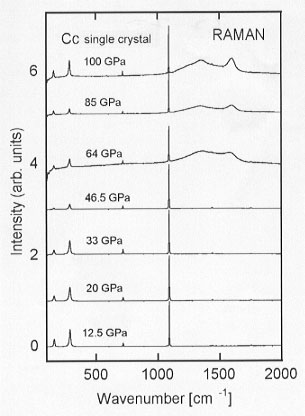

Shock experiments are an indispensable tool in simulating natural impact processes and, in particular, shock damage in rock-forming minerals. Our knowledge of the shock behavior of carbonates is relatively limited; at very high shock pressures and temperatures carbonates are assumed to show substantial CO2 release. This devolatilisation process may have been particularly significant for the K/T mass extinction as the Chicxulub bolide impacted an anhydrite-rich carbonate platform.
In order to address the question of the shock behavior of calcite, we have carried out systematic shock experiments in a wide peak-pressure range from 10 to 100 GPa. From the bottom to the top, the experimental setups consist of two steel blocks, a 10 mm wide spacing ring, a 2 - 4 mm thin iron flyer plate, and the high-explosive. The upper steel block contains an ARMCO iron cylinder (45 mm in diameter) with the encapsulated sample disk. This design allows complete recovery of the 10 mm diameter, 0.5 mm thick sample disks. Pressures > 60 GPa were produced using octogen, whereas TNT or Composition B were used to achieve lower pressures. Peak pressures are reached by multiple reflections of the shock wave at the sample-iron interfaces. To compensate for the rather low shock temperatures induced by this reverberation technique, we have not only used single crystals but also calcite powder. The high porosity of the powders causes post-shock temperatures that can be up to one order of magnitude higher than in experiments with single crystals.
Recovered single crystals were systematically analysed by X-ray diffraction, Raman spectroscopy, and electron microscopy. Within the error limits, the lattice constants a and c of shocked calcites are identical to those of the unshocked reference sample. Thus, calcite behaves distinctly differently from other minerals, which tend to amorphise under shock compression (e.g., quartz and feldspar). Raman spectroscopy carried out on the complete series of shocked single crystals shows the presence of two additional, very broad bands (at ca. 1350 and 1550 cm-1) at pressures  64 GPa (Fig. 3.7-7). Such bands are typical for microcrystalline graphite, amorphous carbon, and unbonded CO32- groups. On the other hand, transmission electron microscopy failed to detect any carbon phase and shows only a high dislocation density of about 1014 m-2. At present, it remains unresolved whether the dislocations could be the cause for the additional Raman bands.
64 GPa (Fig. 3.7-7). Such bands are typical for microcrystalline graphite, amorphous carbon, and unbonded CO32- groups. On the other hand, transmission electron microscopy failed to detect any carbon phase and shows only a high dislocation density of about 1014 m-2. At present, it remains unresolved whether the dislocations could be the cause for the additional Raman bands.
 |
Fig. 3.7-7: Raman spectra of calcite single crystals shocked to pressures between 10 and 100 GPa.
|

Tel: +49-(0) 921 55 3700 / 3766, Fax: +49-(0) 921 55 3769, E-mail: bayerisches.geoinstitut(at)uni-bayreuth.de
 Previous page
Previous page